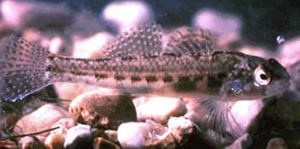Fountain darter facts for kids
Quick facts for kids Fountain darter |
|
|---|---|
 |
|
| Conservation status | |
| Scientific classification | |
| Synonyms | |
|
The fountain darter (Etheostoma fonticola) is a species of freshwater ray-finned fish, a darter from the subfamily Etheostomatinae, part of the family Percidae, which also contains the perches, ruffes and pikeperches. It is found in the headwaters of only two rivers in Texas, United States: the Comal River and the San Marcos River. It is generally smaller than 3 cm (1.2 in) long and feeds on small invertebrates. It is a federally listed endangered species of the United States and is also listed as endangered by the IUCN.
Contents
Distribution and habitat
The fountain darter is known from only two locations, primarily the headwaters of the spring-fed San Marcos River, having been observed as far as 1.25 miles downstream, as well as the upper reaches of the Comal River in central Texas. Its geographic isolation is reflective of its incredibly specific habitation preferences which demand conditions which can only be found in these, two, Texas river headwaters alone. In these unique locations they can be observed in open areas created by a medium current at depths of 3-5feet near the outlets of contributing spring heads with rates of flow low enough to retain a layer of percolating sand. These springs can be found adjacent to the main springs that deliver the tremendous volumes of cool, perfectly clear water that forms each river. They require a stable water temperature, within the low 70s, year round which the springs provide. These two locations are uniquely suited habitat as these ecosystems’ diversity and ultra-high densities of plant and animal life are unparalleled, with quantities exponentially surpassing each and every ecosystem within the region and all surrounding regions.
Behavior
The fountain darter feeds on small invertebrates. It breeds all year round and the eggs are deposited on dead leaves, stems, rocks, algae or other objects. This fish lives for one to two years.
Status
They primarily occupy the sandy tops of lesser flowing springheads or flat rock surfaces absent of rooted plants, or decaying plant matter and spawn within the vibrantly abundant and healthy vegetation that thrives in these unique, pristine, springfed river systems. Due to the overuse and subsequent abuse of their isolated and specific habitat which primarily stems from the behaviors of some of the many thousands of river tourist who, unaware or who don't care, regularly destroy these areas. In addition to the financially motivated, less than perfect, enforcement of the blatant ecological devastation caused by tourism, deep pocketed development interests actively seek to acquire and be permitted to build on and around the darter's ultra-prime habitat due to the unparalleled beauty of these ecologically unique areas. An extra worry for the future of fountain darters is the parasitic, non-native trematode (Centrocestus formosanus), whose impact on the darter population is not yet known. As of 2004, only the Comal population is seriously affected by the parasite. The National Fish Hatchery and Technology Center in San Marcos keeps a reserve population of 500 adults as a hedge against a man-made or natural event wiping out the fish in the wild. The IUCN rates this species as "Endangered". Conservation efforts include encouraging people to use less water in order to maximise water flow from the springs and to keep the rivers free from trash.
- Froese, Rainer, and Daniel Pauly, eds. (2011). "Etheostoma fonticola" in FishBase. 09 2011 version.
See also
 In Spanish: Etheostoma fonticola para niños
In Spanish: Etheostoma fonticola para niños


